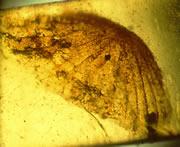 Mushroom hunting in amber brought this prize specimen.Poinar G. & Buckley R. Mycological Research
Mushroom hunting in amber brought this prize specimen.Poinar G. & Buckley R. Mycological ResearchOREGON An unusual fossil-hunting team has hit upon an unusual discovery: the oldest found mushroom fossil yet, encased in amber along with a striking example of a parasite feeding upon a parasite. Dated to 100 million years ago by the age of material surrounding the amber, the mushroom joins the exclusive company of just a handful of fossilized fleshy fungal bodies ever found.
The chance of finding such a specimen is tiny. But, George Poinar, an Oregon State University zoologist and president of The Amber Institute, in Corvallis, Oregon, and Ron Buckley, a registered nurse and amateur fossil hunter from Florence, Kentucky, were the lucky amber-obsessed duo to discover it.
Poinar's fossil interest is a family affair — sparked when his mother showed him pictures of beetles in amber. His subsequent scientific career investigating amber proved inspiration for the movie Jurassic Park.
Buckley's amber fascination is also a money-making venture. Over the past decade, he has sifted through 20,000 pieces of amber, primarily from Burma. He sells collectable pieces with trapped bugs or flowers on eBay, an online auction website. Over time, he's honed a sharp eye for pieces of scientific interest — which he sends to Poinar. So far, they say they have discovered the oldest-known bee, the oldest-known flowers in amber and the oldest-known ticks. Their oldest find yet is a 130 million-year-old nematode parasite of a fly.
Mushroom tree
Unfortunately, the mushroom fossil, reported in Mycological Research1, won't shed any particular light on mushroom evolution. Previous studies of modern mushroom DNA help to show that mushrooms must have appeared more than 100 million years ago, so it's mere existence isn't surprising. Another amber-preserved mushroom specimen has previously been found from the Cretaceous period (145-65 million years ago) — a sample holding two gilled mushrooms from 90-94 million years ago, found in New Jersey.
To learn more, they would need to extract DNA from such samples, to help slot them into their specific place in the mushroom family tree. This could help to fine-tune 'molecular clock' studies, which use comparisons of mushroom genomes to help date when different species diverged in the past. "If it was possible to confidently ascribe the fossils to specific taxonomic classification, then these findings might be helpful for constraining dates in molecular clock studies," says David Hibbett, a mycologist at Clark University in Worcester, Massachusetts, who has studied the previous Cretaceous mushroom find2.
But it is impossible to determine from visual inspection of this specimen the taxonomic category the mushroom belongs to, and it's not possible to extract its DNA, says Rytas Vilgalys, a mycologist at Duke University in Durham, North Carolina.
Poinar's team has extracted DNA from other amber-encased specimens — notably a 125-million-year-old weevil3. But such claims have met with skepticism in the scientific community due to concerns about contamination of the genetic material. Regardless, Poinar says he has no plans to extract DNA from the mushroom. "With a specimen so rare, we don't want to destroy it," he says.
All around the world
Though lacking scientific utility in evolution studies, the specimen does shed light on prehistoric mushroom ecology. Poinar's specimen was found in Asia, while Hibbett's Cretaceous mushroom was found in New Jersey, indicating that they were wide-spread at the time.
ADVERTISEMENT
Poinar also analyzed the amber using nuclear magnetic resonance and compared it to the spectra obtained from modern tree resins. This hints that the amber came from a member of the Araucariaceae family such as kauri pine, leading Poinar to believe this ancient forest was similar to modern forests in northern New Zealand.
The amber also holds the remains of an ancient parasitic relationship. The sample contains a mycoparasite, or fungus growing on the mushroom, and a hyperparasite growing on the mycoparasite. Poinar first noted the characteristic threads of the mycoparasite growing over the mushroom cap, which the parasite uses to enter and consume the mushroom. Then he noticed the strands of a hyperparasite that had invaded the mycelium to absorb its nutrients. "Even a well-trained field mycologist might not recognize that in the field," says Vilgalys. But Buckley knew he had something special the minute he saw it.
Visit our collectorshitonoldest.html">newsblog to read and post comments about this story.
